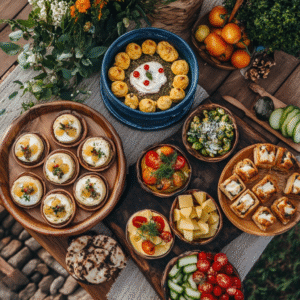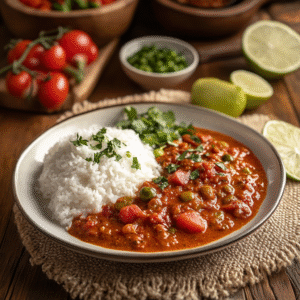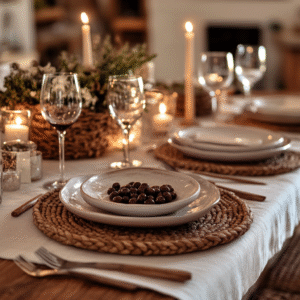1. Introduction: Elevate Entertaining with Plant‑Based Flair
Hosting a memorable gathering goes beyond good company—it’s about creating an immersive culinary experience. Learning How to Host a Vegan Dinner party allows you to showcase compassionate cuisine, highlight seasonal produce, and impress guests with dishes that burst with flavor and texture. Unlike standard dinner parties, a vegan menu underscores sustainability, health, and creativity without compromising taste.
1.1 The Appeal of Vegan Entertaining
Vegan dinner parties resonate for several reasons:
Ethical & Environmental Impact: Plant‑based menus reduce carbon footprint and animal‑welfare concerns.
Health Focus: Guests consume fiber‑rich, nutrient‑dense foods that support digestion and vitality.
Culinary Creativity: Removing animal products challenges hosts to innovate with grains, legumes, nuts, and vegetables.
1.2 Setting Expectations
Communicate clearly in your invites that all dishes are 100 % plant‑based. Provide a brief menu preview—“Mediterranean‑style mezze, autumn harvest mains”—so guests anticipate new flavors. Encourage RSVPs with allergy info via a quick online form to capture nut, soy, or gluten sensitivities.
1.3 Overview of This Guide
In Part 1, we will cover:
Planning: Guest profiles, theme selection, budgeting, and sourcing.
Menu Design: Principles for balanced courses and beverage pairings.
Starters: Three appetizer recipes with prep tips.
Main Courses: Two show‑stopping entrees.
By the end, you’ll have a solid framework to plan, cook, and present an elegant vegan dinner that delights every palate.
2. Planning Your Vegan Dinner Party
Success begins long before the first dish hits the table. A detailed plan ensures smooth execution and relaxed hosting.
2.1 Defining Your Guest List & Dietary Needs
Size & Setting: Decide between an intimate table for 6–8 or a buffet for 12–16.
Dietary Restrictions: Ask each guest about nuts, soy, nightshades, or gluten via a simple Google Form.
Experience Level: Gauge adventurous eaters vs. comfort‑food seekers to balance menu boldness.
2.2 Choosing a Theme & Ambiance
A cohesive theme streamlines décor, music, and menu cohesion:
Rustic Autumn Harvest: Earthy table linens, votive candles in mason jars, folk music.
Modern Mediterranean: White linens, olive‑wood boards, bouzouki or acoustic guitar playlist.
Asian Fusion: Low seating, bamboo placemats, soft koto or shakuhachi instrumentals.
2.3 Budgeting & Ingredient Sourcing
Per‑Person Estimate: Allocate roughly $15–$20 per guest for a three‑course vegan meal (excluding alcohol).
Bulk Staples: Purchase lentils, chickpeas, grains, and nuts from bulk bins to save 30–40 %.
Local Market Finds: Visit farmers’ markets for seasonal produce nearing end‑of‑day markdowns.
Specialty Items: Reserve small portions of vegan cheese or artisanal breads for a gourmet touch.
2.4 Timeline & Task Delegation
Four Weeks Out: Finalize guest list, theme, and budget.
Two Weeks Out: Order specialty items (vegan cheeses, imported olives), confirm RSVPs.
One Week Out: Create detailed shopping list, prep dry mixes, and marinade proteins.
Two Days Out: Chop vegetables, soak nuts/legumes, prepare dips and sauces.
Day Of: Bake breads, assemble starters, time mains, set table 2 hours before guests arrive.
3. Crafting a Balanced Menu
A well‑balanced menu harmonizes flavors, textures, and nutrition across courses.
3.1 Flavor & Texture Harmony
Flavors: Sweet, salty, sour, bitter, umami—each course should feature at least two.
Textures: Creamy dips, crispy crostini, tender roasts, crunchy salads.
3.2 Course Structure
Welcome Nibbles & Cocktail: Light bites to stimulate appetite.
Appetizers: Flavorful yet not too filling (e.g., tartlets, dips).
Salad or Soup: A palate‑cleansing interlude (e.g., beet and citrus salad; butternut‑apple soup).
Main Entrée: Hearty centerpieces with complementary sides.
Dessert: Balanced sweetness and textural contrast.
Digestif: Herbal tea or small glass of vegan liqueur.
3.3 Beverage Pairings
Non‑Alcoholic: Infused waters (cucumber‑mint), housemade kombucha.
Wines:
Crisp Sauvignon Blanc with salads and mineral‑driven dishes.
Medium‑bodied Pinot Noir alongside mushroom‑based mains .
Mocktails: Pomegranate‑ginger fizz or rosemary‑grapefruit spritzer for a signature touch.
4. Appetizer & Starter Recipes
4.1 Cashew Herb Dip with Crudité Platter
Ingredients & Method: Soak 1 cup raw cashews 4 hrs; drain and blend with 1 garlic clove, 2 Tbsp lemon juice, ¼ cup mixed fresh herbs (parsley, basil, dill), salt, and 3–4 Tbsp water until creamy. Chill.
Presentation: Arrange colorful vegetables—heirloom carrots, radish halves, snap peas, cherry tomatoes—around a shallow bowl of dip. Garnish with herb sprigs and a drizzle of olive oil.
Make‑Ahead Tip: Prepare dip 2 days prior; store airtight.
4.2 Mini Mushroom & Thyme Tartlets
Ingredients & Method: Sauté 2 cups chopped mixed mushrooms with 1 Tbsp olive oil, 1 small diced onion, 1 tsp fresh thyme, salt, and pepper until moisture evaporates. Roll out vegan puff‑pastry sheet, cut into 12 rounds, press into mini‑muffin tin, fill with mushroom mix, bake at 375 °F for 20 min.
Serving: Warm on a platter, sprinkle microgreens atop each tart.
For more vegan baking tips, see our Gluten‑Free Vegan Baking: Tips & Tasty Recipes.

4.3 Spiced Roasted Chickpeas & Crispy Shallots
Ingredients & Method: Toss 2 cans drained chickpeas with 1 Tbsp olive oil, 1 tsp smoked paprika, ½ tsp ground cumin, salt. Roast 400 °F for 25 min until crisp. Thinly slice 2 shallots, coat lightly with flour, fry until golden.
Serving: Combine chickpeas and shallots in small bowls. Provide toothpicks for easy grazing.
5. Main Course Showstoppers
5.1 Lentil‑Walnut “Meatloaf”
Ingredients & Method: Pulse 1 cup cooked brown lentils and 1 cup walnuts in a food processor; mix with ½ cup breadcrumbs, 1 tsp dried oregano, 1 Tbsp tomato paste, 1 Tbsp soy sauce, 1 small diced onion, salt, and pepper. Press into loaf pan; bake 350 °F for 45 min, brushing with glaze of 2 Tbsp ketchup & 1 Tbsp maple syrup in final 10 min.
Serving: Slice thickly and arrange on platter with parsley sprigs.
5.2 Coconut‑Red Curry Chickpea Stew
Ingredients & Method: In a pot, sauté 1 Tbsp coconut oil, 1 sliced onion, and 2 cloves garlic until translucent; stir in 1 Tbsp red curry paste, 1 can coconut milk, 2 cans chickpeas, 1 cup vegetable broth, and 1 sliced bell pepper. Simmer 15 min. Finish with lime juice and chopped cilantro.
Serving: Spoon over steamed jasmine rice or serve alongside warm naan.

6. Side Dishes & Salads
Side dishes and salads provide color, texture, and nutritional variety, rounding out your How to Host a Vegan Dinner menu with complementing flavors.
6.1 Roasted Root Vegetable Medley
Toss chunks of sweet potato, parsnip, and beetroot with olive oil, rosemary, salt, and pepper; roast at 425 °F for 30 minutes until caramelized. Finish with a drizzle of balsamic reduction and chopped parsley. This dish offers earthy sweetness and a tender-crisp contrast to a hearty main.
6.2 Lemon‑Garlic Quinoa Pilaf
Sauté diced onion and garlic in olive oil until fragrant, stir in rinsed quinoa, and toast briefly. Add vegetable broth, lemon zest, and juice; simmer covered until liquid absorbs. Fluff with a fork, fold in toasted pine nuts and fresh dill. Citrusy brightness balances richer entrees.
6.3 Kale‑Apple Slaw with Maple‑Mustard Vinaigrette
Shred kale and thinly slice tart apples; toss with a dressing made from Dijon mustard, maple syrup, apple cider vinegar, and olive oil. Top with toasted sunflower seeds for crunch. This salad adds vibrant greens and tang that refresh the palate between courses.
6.4 Charred Cauliflower Steaks with Tahini Drizzle
Cut cauliflower into ½″ “steaks,” brush with olive oil, salt, and smoked paprika, then broil until edges char. Drizzle with a tahini‑lemon sauce (tahini, water, lemon juice, garlic) and sprinkle with pomegranate arils for color. Smoky, creamy, and jewel‑like, these steaks elevate side‑dish status.
7. Desserts & Drinks
Ending on a sweet note and offering thoughtful beverages solidifies the dining experience.
7.1 Decadent Flourless Black Bean Brownies
Blend black beans, cocoa powder, maple syrup, almond butter, and vanilla; pour into a lined pan and bake at 350 °F for 20 minutes. The result is fudgy, protein-rich brownies that satisfy chocolate cravings without refined flours. Serve with a dusting of powdered sugar or vegan whipped cream.
7.2 Lemon‑Lavender Sorbet
Combine water, sugar, lemon juice, and a tablespoon of culinary lavender; simmer, strain, and chill. Churn in an ice‑cream maker or freeze, stirring every 30 minutes, until smooth. The floral notes and citrus zing cleanse the palate after rich courses.
7.3 Signature Mocktail: Rosemary‑Grapefruit Spritzer
Muddle fresh rosemary in a shaker, add grapefruit juice and a splash of maple syrup, shake with ice, strain into glasses, and top with sparkling water. Garnish with a rosemary sprig. This bright, herbaceous drink pairs well with both savory and sweet dishes.
7.4 Wine Pairings Recap
Sparkling Rosé: Celebratory and light with appetizers.
Chardonnay (unoaked): Complements creamy dips and cauliflower steaks.
Zinfandel or Syrah: Stands up to lentil loaf’s hearty umami.
Dessert Wine: A late‑harvest Riesling or vegan port with brownies and sorbet .
8. Table Setting & Ambiance
The environment you create enhances every bite and conversation.
8.1 Place Settings & Centerpieces
Use neutral tablecloths with vibrant napkins to reflect your theme. Layer recycled‑glass chargers under ceramic dinner plates. Centerpieces can be simple—potted succulents or seasonal produce (mini pumpkins, citrus fruits) in wooden crates. Avoid clutter; ensure comfortable elbow room.
8.2 Lighting & Music
Soft, warm lighting from candles or dimmable bulbs creates intimacy. For a modern vibe, string Edison bulbs overhead. Curate a playlist that matches your theme: acoustic folk for rustic, smooth jazz for elegant evenings, world‑music instrumentals for global fusion menus. Keep volume low for unobstructed conversation.
8.3 Dinnerware & Utensils
Opt for reusable or compostable bamboo flatware to minimize waste. Provide water carafes and wine decanters at each table. Place small bowls of flavored salts, peppercorns, or red-pepper flakes for guests to customize seasoning.
External Resources & Video Tutorial
For authoritative food‑safety guidelines, consult the CDC’s official Food Safety resources, which cover safe food handling, cross‑contamination prevention, and temperature controls for home cooks . For step‑by‑step inspiration on plating and ambiance, watch the viral YouTube video “Vegan Dinner Party Menu Ideas” by Pick Up Limes (1.2 M views), featuring creative recipes, table‑setting tips, and hosting advice.
9. Cooking Timeline & Workflow
A clear timeline prevents last‑minute stress and ensures dishes arrive hot and perfectly plated.
9.1 Two Days Before
Chop vegetables and store in airtight containers.
Soak beans, lentils, or nuts for dips and mains.
Prepare dessert dough or sorbet base; refrigerate.
9.2 One Day Before
Bake breads, brownies, and loafs; cool and wrap.
Cook quinoa and roast roots; reheat on party day.
Whisk vinaigrettes and store separately.
Set table or layout décor elements.
9.3 Party Day
5 Hours Before: Marinate tofu/tempeh and prep tartlet filling.
3 Hours Before: Begin main-course cooking; switch oven racks as needed.
1.5 Hours Before: Reheat side dishes; assemble salads but don’t dress.
30 Minutes Before: Bake tartlets; blend sorbet bases if needed.
15 Minutes Before: Dress salads, carve loaf, lay out appetizers, and chill drinks.
At Start Time: Light candles, cue music, welcome guests with mocktails.
10. Special Considerations (Allergies, Budget & Sustainability)
Ensuring everyone feels included and comfortable is essential.
10.1 Allergy‑Friendly Substitutions
Nut Allergies: Replace cashew cream with sunflower seed cream; swap nut milks for oat or rice milks.
Gluten‑Free Guests: Use certified gluten‑free puff pastry and bread; serve quinoa pilaf instead of couscous.
Soy Sensitivities: Offer chickpea‑based protein alternatives (falafel) instead of tofu or tempeh.
10.2 Budget‑Conscious Hosting
Buy in bulk for staples (grains, beans, spices).
Choose seasonal produce and on‑sale items.
Repurpose leftovers into next-day bowls or guest takeaways in compostable containers.
10.3 Eco‑Friendly Practices
Source local and organic where possible to reduce transportation footprint.
Compost vegetable scraps and coffee grounds.
Use washable linens and rechargeable LED candles.
Donate unopened leftovers to food-sharing programs.
11. Hosting Etiquette & Interactive Games
Encourage engagement and make your vegan dinner party memorable beyond the meal.
11.1 Welcoming Guests
Greet each guest at the door with a brief menu explanation—“Tonight we’re exploring Mediterranean‑inspired flavors, all 100 % plant‑based.” Offer a welcome drink and designate a coat/bag area.
11.2 Conversation Starters
Place simple questions under each plate—“What’s your favorite comfort vegan dish?” or “Name a fruit or vegetable you’ve never tried.” These prompts foster fun dialogue and culinary exploration.
11.3 Interactive Pairings Game
Provide small cards with pairing suggestions (e.g., “Which side pairs best with the meatloaf: slaw or quinoa?”). Guests vote with tokens, then taste both and discuss favorites—turning dinner into a tasting adventure.
11.4 Closing Ritual
End with a communal toast—sparkling water, herbal tea, or dessert wine—and a shared moment of gratitude for the food, company, and effort invested.

Frequently Asked Questions
Q1: How do I accommodate mixed dietary preferences when learning How to Host a Vegan Dinner?
Design menu items with broad appeal—such as stuffed mushrooms or curry stews—and clearly label each dish as gluten‑free, nut‑free, or soy‑free to guide guests.
Q2: How to Host a Vegan Dinner if my oven space is limited?
Leverage countertop appliances (Instant Pot for stews, toaster oven for tartlets) and stagger cooking times according to your detailed timeline to maximize available space.
Q3: How can I reduce kitchen stress while I Host a Vegan Dinner?
Delegate key tasks—ask a friend to manage amuse‑bouche or a family member to refill drinks. Use pre‑portioning and checklists to stay organized.
Q4: How to Host a Vegan Dinner with advance prep?
Many components (dips, breads, salads undressed, desserts) can be prepared 1–2 days ahead. Reheat mains and sides on party day according to your cooking timeline.
Q5: How to Host a Vegan Dinner and ensure seamless flow?
Create a “command station” with all utensils, serving dishes, and warming trays in one area. Use timers and your pre‑written schedule so each course launches on time.
Conclusion & Next Steps
Hosting a standout vegan dinner party combines thoughtful planning, creative recipes, and warm hospitality. You’ve learned How to Host a Vegan Dinner from guest-list management to menu curation, cooking timelines, and engaging activities.
Finalize your guest list and theme.
Shop and prep two days in advance.
Set up your space and rehearse the flow.
Delegate tasks and enjoy the evening!
For those interested in learning more about this topic, we recommend this vegan cookbook.